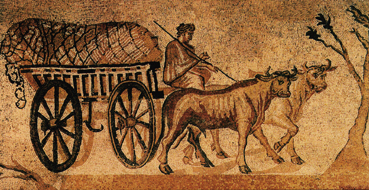Versatility: The Square-sided Bottle


Square-sided bottle
Ht., 1604 cm
2nd century A.D.
Inv. MS 5621
"Vessels should be either earthenware or glass, and should be numerous rather than large, and some of them should be properly treated with pitch, but some in their natural state as the condition of the material preserved demands." (Columella, On Agriculture XII.4)
For long distance sea- and river-borne transport of domestic consumables such as wine, olive oil, and fish sauce (garum), the Romans used pottery amphorae with a capacity of six gallons or more. Once these consumables reached a city's warehouses, however, they would be decanted into glass vessels with a capacity of about a pint or two. Bottled and jars could be loaded onto hand-carts and taken to the thousands of retail shops that were scattered throughout the city's narrow streets.
Any of the bottles that were carted to outlying towns or villas eventually became storage containers in someone's kitchen or cellar, Others were re-filled and packed off to another market in a neighboring region. An ongoing cycle of sale, storage, emptying, and refilling—perhaps with a different liquid each time—gave some bottles a useful life of many decades, and a range of travel many times greater than the original one.
REFERENCES
- Charleworth, D., 1966: "Roman Square Bottles," Journal of Glass Studies8, 26-40.
- Meijer, F., and Nijf, O. van, 1992: Trade Transport and Society in the Ancient World, 60-102 (New York: Routledge).
- Middleton, P., 1983: "The Roman Army and Long Distance Trade,” in Trade and Famine in Classical Antiquity, 75-83 (Cambridge: Cambridge Philosophical Society).
- Price. J., 1978: “Trade in Glass,” in Roman Shipping and Trade: Britain and the Rhine Provinces, 70-78 (edits., J. du Plat Taylor and H. Cleere; London: C.B.A).

"The Laden Ox-cart"
Detail from a floor mosaic in a guest house at Orbe, in Switzerland
3rd century A.D.
